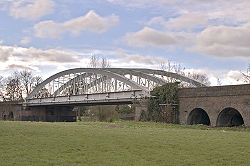Windsor Railway Bridge: Difference between revisions
No edit summary |
No edit summary |
||
| (One intermediate revision by one other user not shown) | |||
| Line 7: | Line 7: | ||
|picture caption=The wrought iron railway bridge.<BR>''(Buckinghamshire side, looking towards Windsor)'' | |picture caption=The wrought iron railway bridge.<BR>''(Buckinghamshire side, looking towards Windsor)'' | ||
|carries=Slough to Windsor & Eton Line | |carries=Slough to Windsor & Eton Line | ||
|crosses= | |crosses=River Thames | ||
|design=Bow and string | |design=Bow and string | ||
|material = Wrought Iron | |material = Wrought Iron | ||
| Line 16: | Line 16: | ||
==Structure== | ==Structure== | ||
The bridge is a single-span structure comprising three bowstring trusses which created two bays for the original two GWR tracks.<ref>Humber, William (1870). [https://books.google.com/books?id=1SJRAAAAYAAJ&printsec=frontcover&dq=A+Complete+Treatise+on+Cast+and+Wrought+Iron+Bridge+Construction&hl=en&sa=X&ei=z5zxT-qtN4bAtAaM3tmODw&redir_esc=y#v=onepage&q&f=false ''A Complete Treatise on Cast and Wrought Iron Bridge Construction'']; Description of ''Windsor Bridge'' (1849), pp. 245-246. Lockwood & Co., London. Retrieved 2012-07-03.</ref> The bridge is the World's oldest wrought iron railway bridge still in regular service,<ref>[http://www.mybrunel.co.uk/bridges/windsor.php Isambard Kingdom Brunel]</ref> and is a forerunner of Brunel's final masterpiece, the [[Royal Albert Bridge]], [[Saltash]].<ref name=IoE/> The bridge was Grade-II* listed in 1975.<ref name=IoE>{{ | The bridge is a single-span structure comprising three bowstring trusses which created two bays for the original two GWR tracks.<ref>Humber, William (1870). [https://books.google.com/books?id=1SJRAAAAYAAJ&printsec=frontcover&dq=A+Complete+Treatise+on+Cast+and+Wrought+Iron+Bridge+Construction&hl=en&sa=X&ei=z5zxT-qtN4bAtAaM3tmODw&redir_esc=y#v=onepage&q&f=false ''A Complete Treatise on Cast and Wrought Iron Bridge Construction'']; Description of ''Windsor Bridge'' (1849), pp. 245-246. Lockwood & Co., London. Retrieved 2012-07-03.</ref> The bridge is the World's oldest wrought iron railway bridge still in regular service,<ref>[http://www.mybrunel.co.uk/bridges/windsor.php Isambard Kingdom Brunel]</ref> and is a forerunner of Brunel's final masterpiece, the [[Royal Albert Bridge]], [[Saltash]].<ref name=IoE/> The bridge was Grade-II* listed in 1975.<ref name=IoE>{{NHLE|1319297|accessdate=16 September 2008}}</ref> | ||
==Opening== | ==Opening== | ||
| Line 31: | Line 31: | ||
{{Reflist}} | {{Reflist}} | ||
{{Thames bridges}} | |||
{{ | |||
Latest revision as of 20:44, 21 October 2019
| Windsor Railway Bridge | |
| Buckinghamshire, Berkshire | |
|---|---|
 The wrought iron railway bridge. (Buckinghamshire side, looking towards Windsor) | |
| Location | |
| Carrying: | Slough to Windsor & Eton Line |
| Crossing: | River Thames |
| Location | |
| Location: | 51°29’13"N, -0°37’5"W |
| Structure | |
| Design: | Bow and string |
| Material: | Wrought Iron |
| History | |
| Built 1849[1] | |
| Information | |

Windsor Railway Bridge is a wrought iron 'bow and string' bridge near Windsor, designed by Isambard Kingdom Brunel. It carries the ex-Great Western Railway branch line from Slough to into Windsor and Eton Central station. It crosses the River Thames, which here forms the border between Buckinghamshire and Berkshire, on the reach between Romney Lock and Boveney Lock.
Structure
The bridge is a single-span structure comprising three bowstring trusses which created two bays for the original two GWR tracks.[2] The bridge is the World's oldest wrought iron railway bridge still in regular service,[3] and is a forerunner of Brunel's final masterpiece, the Royal Albert Bridge, Saltash.[1] The bridge was Grade-II* listed in 1975.[1]
Opening
The line opened in 1849. The construction of the line was delayed and could not be included in the original Parliamentary Act because of objections from the Provost of Eton College. The brick viaduct was constructed between 1861-65 to replace the original wooden trestle viaduct. The bridge contractor was Mr George Hannet.
Track layout
Although the bridge was built to take two tracks, the track on the upstream side was removed when the line was rationalised in the 1960s. The trackbed on this side now carries a sewage or water main pipe.
See also
References
| ("Wikimedia Commons" has material about Windsor Railway Bridge) |
- ↑ Jump up to: 1.0 1.1 1.2 National Heritage List 1319297: Windsor Railway Bridge
- ↑ Humber, William (1870). A Complete Treatise on Cast and Wrought Iron Bridge Construction; Description of Windsor Bridge (1849), pp. 245-246. Lockwood & Co., London. Retrieved 2012-07-03.
- ↑ Isambard Kingdom Brunel
| Bridges and crossings on the River Thames | ||||||
|---|---|---|---|---|---|---|
| M4 Thames Bridge | Summerleaze Footbridge | Queen Elizabeth Bridge | Windsor Railway Bridge | Windsor Bridge | Black Potts Railway Bridge | Victoria Bridge |